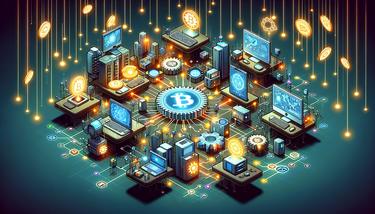Virtual assets as a technical instrument
Virtual assets[1] have evolved beyond mere financial instruments, playing a pivotal role in various technical domains. This document explores their utility in technology-driven applications and ecosystems.
- Utility in Blockchain Technology
- Enhancing Digital Identity and Authentication
- Powering Decentralized Applications (DApps)
- Facilitating Smart Contracts
- Key Facts
- Virtual assets as a technical instrument
- Defining Virtual Assets
- Blockchain: The Backbone of Virtual Assets
- Types of Virtual Assets
- Regulation and Compliance of Virtual Assets
- Virtual Assets and the Global Economy
- Security and Risks in Virtual Asset Transactions
- Future Trends and Developments in Virtual Assets
Utility in Blockchain Technology
Virtual assets are integral to the operation and security of blockchain networks, facilitating transactions, incentivizing participation, and enabling decentralized governance.
Enhancing Digital Identity and Authentication
Through the use of cryptographic assets, blockchain technology offers advanced solutions for digital identity verification[3], enhancing security and privacy in online transactions.
Powering Decentralized Applications (DApps)
Virtual assets serve as the backbone for DApps, providing the necessary resources and economic incentives for their operation and development within decentralized networks.
Facilitating Smart Contracts
Smart contracts utilize virtual assets for the execution of contract terms on blockchain platforms, automating agreements without the need for intermediaries.
Virtual assets have become indispensable in the realm of technical innovation, offering solutions that enhance security, efficiency, and decentralization[5] in digital ecosystems.
Key Facts
- Virtual assets enable transactions and incentivize participation in blockchain networks.
- Blockchain technology, powered by virtual assets, offers enhanced solutions for digital identity and authentication.
- Decentralized applications (DApps) rely on virtual assets for their operation and economic model.
- Smart contracts automate agreements in a trustless environment using virtual assets.
Virtual assets as a technical instrument
Virtual assets, often synonymous with digital assets or cryptographic assets, represent a significant innovation in the financial and technological landscape, embodying the convergence of finance, technology, and digital culture. As technical instruments, virtual assets encompass a broad range of digital representations of value, from cryptocurrencies[6] like Bitcoin[7] and Ethereum[8] to tokenized assets and digital collectibles. Their emergence and growing acceptance have prompted a reevaluation of traditional financial systems[9], investment strategies, and notions of ownership and value transfer in the digital age.
Defining Virtual Assets
Virtual assets are digital representations of value that can be traded, transferred, and used for payment or investment purposes. Unlike traditional financial assets, virtual assets operate on digital platforms, primarily utilizing blockchain technology to ensure security, transparency[10], and immutability[11]. This foundational chapter introduces the concept of virtual assets, exploring their characteristics, types, and the underlying technology that enables their existence.
Blockchain: The Backbone of Virtual Assets
Blockchain technology is the bedrock upon which virtual assets stand. This chapter delves into how blockchain’s decentralized ledger[12] system facilitates the creation, issuance, and management of virtual assets. It examines the roles of cryptography[13], consensus mechanisms[14], and smart contracts in ensuring the integrity, security, and programmability of virtual assets.
Types of Virtual Assets
From cryptocurrencies to tokenized real-world assets and digital collectibles, the spectrum of virtual assets is vast and varied. This chapter categorizes the main types of virtual assets, highlighting their unique features, use cases, and the value they offer to users and investors. It also explores emerging trends such as non-fungible tokens (NFTs) and decentralized finance (DeFi) instruments.
Regulation and Compliance of Virtual Assets
The regulatory landscape[16] for virtual assets is complex and rapidly evolving. This chapter outlines the challenges and efforts in regulating virtual assets, including the balance between fostering innovation and protecting consumers. It discusses international regulatory frameworks, Know Your Customer (KYC) and Anti-Money Laundering (AML) compliance, and the role of regulatory bodies in shaping the future of virtual asset markets.
Virtual Assets and the Global Economy
Virtual assets are not isolated phenomena; they interact with and impact the global economy. This chapter examines the potential of virtual assets to transform financial services, their influence on monetary policy, and their implications for global trade and investment patterns. It also considers the challenges virtual assets pose to traditional financial systems and central banks.
Security and Risks in Virtual Asset Transactions
Despite their benefits, virtual assets carry inherent risks and security challenges. This chapter addresses the vulnerabilities of virtual asset platforms, the risk of theft and fraud, and the importance of cybersecurity measures[17]. It also discusses the volatility[18] of virtual asset markets and the risk management[19] strategies investors can employ.
Future Trends and Developments in Virtual Assets
Looking ahead, the landscape of virtual assets is poised for continued innovation and expansion. This concluding chapter explores potential future trends in virtual assets, including advancements in blockchain technology, the integration of AI and machine learning, and the potential for virtual assets to drive new economic models and opportunities.
In summary, virtual assets as a technical instrument represent a dynamic and evolving domain, bridging technology and finance in unprecedented ways. Their development and adoption are reshaping economic interactions, challenging traditional notions of value and ownership, and opening new avenues for investment, commerce, and digital innovation.
- Virtual Assets — Digital resources that have value in their use or as an investment, including cryptocurrencies and NFTs.
- Blockchain — A decentralized digital ledger recording cryptocurrency transactions across multiple computers.
- Digital Identity Verification — The process of verifying the identity of individuals or entities digitally, often using cryptographic methods.
- Smart Contracts — Self-executing contracts with terms directly written into code, facilitating, verifying, or enforcing a contract on the blockchain.
- Decentralization — Distribution of power away from a central authority in the management of cryptocurrencies.
- Cryptocurrencies — Digital or virtual currencies that use cryptography for security and operate on a decentralized system, unlike traditional currencies.
- Bitcoin — The first and most well-known cryptocurrency, was introduced in 2009 by Satoshi Nakamoto, who developed Bitcoin.
- Ethereum — A blockchain platform with its own cryptocurrency, Ether, is known for smart contract functionality.
- Financial systems — Complex systems comprising different institutions, including banks, markets, currencies, and policies, that support economic activities.
- Transparency — The characteristic of blockchain technology that allows all transactions to be visible and verifiable by all network participants.
- Immutability — The characteristic of blockchain technology that ensures once data is recorded, it cannot be altered or tampered with, providing a secure and tamper-evident record of transactions.
- Ledger — A digital record of all cryptocurrency transactions, maintained across several computers in a distributed manner.
- Cryptography — The practice of securing communications to prevent third parties from reading them, used in digital currencies for securing transactions.
- Consensus Mechanisms — Processes used in blockchain networks to achieve necessary agreement on a single data value or a single state of the network among distributed processes or multi-agent systems, such as Proof of Work or Proof of Stake, ensuring all transactions are valid and preventing fraud.
- Compliance — The act of adhering to legal standards and regulations established by governmental bodies and regulatory agencies, particularly in the context of financial operations and transactions involving cryptocurrencies.
- Regulatory Landscape — The set of laws, guidelines, and policies that govern the use of virtual assets across different regions.
- Cybersecurity Measures — The technologies and procedures implemented to protect against digital threats and ensure the security of online gambling platforms and user data.
- Volatility — Rapid and significant price movement, a common characteristic of cryptocurrencies.
- Risk Management — The identification, assessment, and prioritization of risks followed by coordinated application of resources to minimize or control the impact of unfortunate events.



